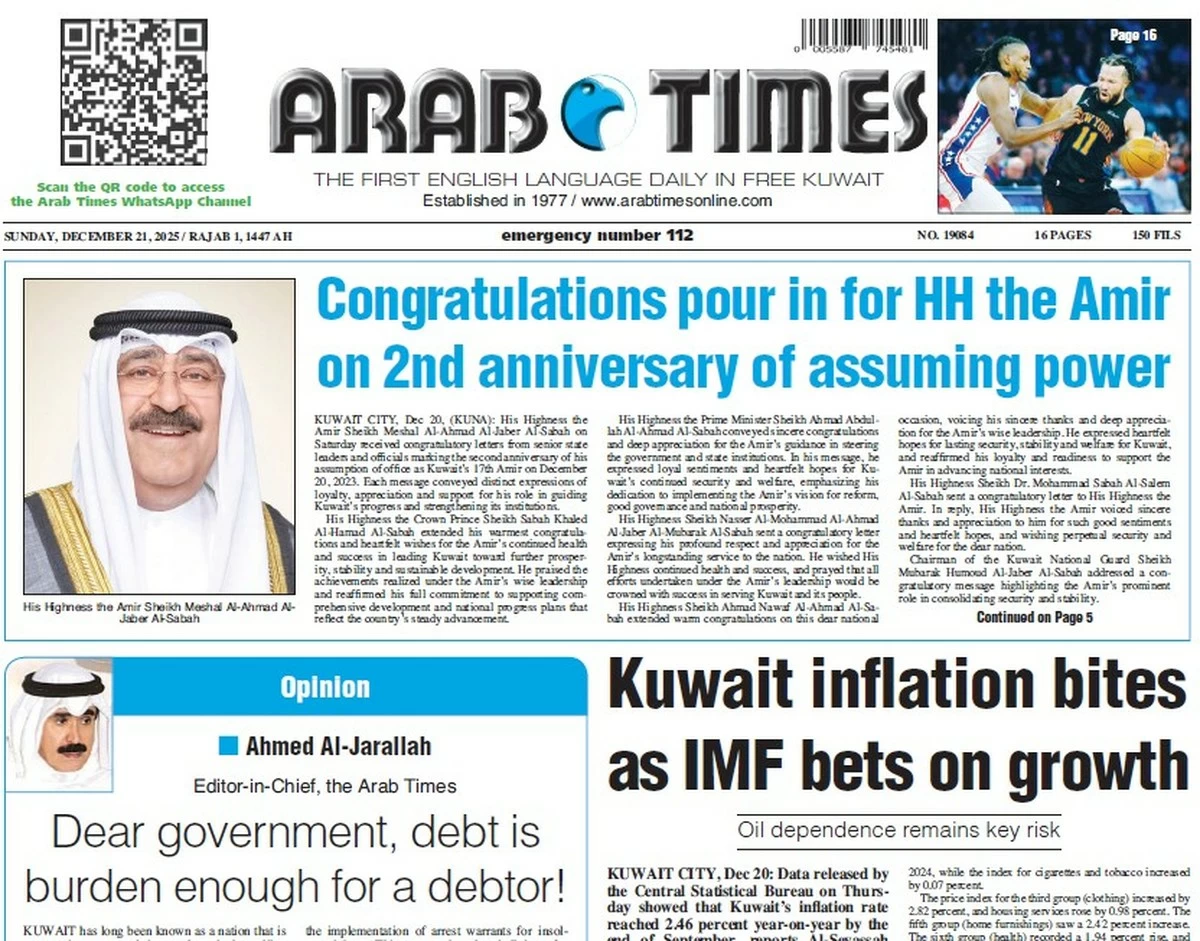23/11/2025
23/11/2025

KUWAIT CITY, Nov 23: Official spokesperson of the Ministry of Electricity, Water and Renewable Energy Eng. Fatima Hayat confirmed that Kuwait has one of the highest per capita water consumption rates in the world, with a daily average of around 100 imperial gallons per person, hence, the need to raise public awareness on judicious water usage.
In an exclusive interview with the newspaper, Hayat underscored the need for the public to fully cooperate with the ministry in ensuring the reliability of water services by increasing the reserve water storage capacity in homes and properties to a minimum of 48 hours.
She affirmed this ensures coverage during emergencies or in case of temporary supply disruptions. She said the ministry continues to urge everyone to fully comply with the water conservation guidelines it issued through its official website and social media accounts, given their impact on maintaining the sustainability of this vital service.
Following is an excerpt of the interview:
Question: What role does the Water Operation and Maintenance Sector play?
Answer: The Sector receives fresh and brackish water from various water facilities, such as pumping stations and reservoirs, and then distributes it through an integrated network of main and branch lines to all areas of Kuwait to guarantee continuous service for consumers round the clock. This includes new connections for homes and modern facilities to ensure that new customers receive water supply according to approved technical specifications, repair leaks and emergency malfunctions through rapid intervention at fault locations, and immediate maintenance works to maintain network efficiency and reduce water loss.
Q: Does the sector play other roles?
A: Another important role is coordinating with those in charge of road and infrastructure development projects to ensure the water network is integrated with other public services and to avoid conflicts that could affect the continuity of water supply. The ministry provides 24/7 customer service by receiving complaints and inquiries, and addressing them promptly to ensure customer satisfaction and service sustainability.
Q: How are faults detected in the water network?
A: Faults are monitored and detected by tracking water pressure in main and branch lines and ensuring it matches the approved operational capacity of the network. This helps detect any abnormal pressure drops or malfunctions. The ministry relies on customer reports received through the unified call center (152), whether by telephone, its mobile application or the official website. Furthermore, the Sahel application provides additional channels for receiving reports and complaints.
Q: What are the most significant updates the ministry has implemented for its fault complaint systems?
A: Over the past period, the ministry developed and updated the system for receiving complaints and service requests through several channels as follows:
- Activate the unified number 152 for receiving complaints through an integrated electronic Outage Management System (OMS), ensuring round-theclock monitoring of reports until their resolution.
- Activate the website, which allows beneficiaries to submit water connection requests and easily add, transfer or modify connections electronically.
- Link with Sahel to enable citizens and expatriates to access a number of water services electronically.
- Continuous updating of water network data on the Geographic Information System (GIS), facilitating rapid access to the locations of main valves and network components during any emergency or scheduled work.
Q: What are the most common types of complaints received by the ministry?
A: Majority of the complaints revolve around weak or interrupted fresh or low-salinity water pressure in some areas or properties, in addition to complaints related to internal or external leaks, as well as reports about changes in the color or taste of the water. All reports are handled according to approved technical procedures and laboratory tests.
Q: What are the main obstacles that the ministry teams usually face during maintenance and emergency works?
A: One of the most difficult challenges is the presence of encroachments on water lines and services, whether from buildings, crops or other civil works, in addition to the intersection of lines with other services such as sewage, telecommunications or electricity. These cases necessitate prior and on-site coordination with several government entities like Kuwait Municipality, Public Authority for Agricultural Affairs and Fish Resources (PAAAFR), Ministry of Public Works, and Ministry of Interior if traffic must be stopped or the site secured.
This may add extra time to reach the leak location and address it safely. Engineering and technical teams are equipped with specialized devices for detecting invisible leaks, especially in cases where complaints are received about low water pressure without any visible leaks on the surface.
These devices are also used for periodic verification of the network’s integrity and contribute to reducing water loss and maintaining network efficiency. Repair time varies depending on the nature of the fault, its location, and the diameter of the damaged water line. However, the estimated repair times for most faults usually range between two to 16 hours. Technical teams are working hard to supply the affected areas with water through alternative sources whenever possible in order to reduce the impact of the interruption on beneficiaries.
By Mohammed Ghanem Al-Seyassah/Arab Times Staff


